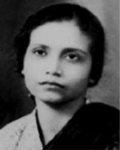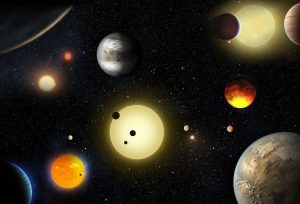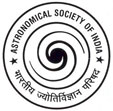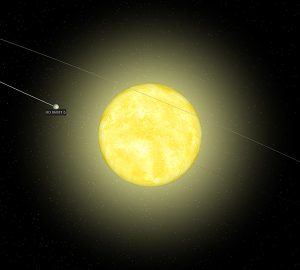Name ExoWorlds (India) - 2019
The results of the contest are out. Scroll below for details.
Name a star and its lonely planet : an opportunity for young Indians
The International Astronomical Union (IAU) is mainly responsible for the naming of astronomical bodies. In this centenary year of the IAU, as part of an international campaign, Indian youngsters got a chance to suggest names for two astronomical objects - the sun-like star HD 86081b and its giant planet. The India national committee worked on this in association with the Astronomical Society of India (ASI).
The winning Indian names are

| Bibhā (बिभा, বিভা) Ananyo Bhattacharya, Surat |
Bibhā [/bɪbɦa/] is the Bengali pronunciation of the Sanskrit word Vibha, which means “a bright beam of light”. It also honours Indian physicist Dr. Bibha Chowdhuri. |
| Santamasa (संतमस) Vidyasagar Daud, Pune |
Santamasa [/səntəməs/] in Sanskrit means “clouded”, which is analogous to the nature of the exoplanet’s atmosphere. |
The naming theme for exoplanet and host star is an analogy to how the physical & lighting conditions of the HD 86081 system might be.

Dr. Bibha Chowdhuri
The National Commitee unanimously believes that this star name, with this particular spelling of it, is of importance to highlight women's contribution in the Indian science community. It honours the unsung Indian physicist Dr. Bibha Chowdhuri (1913-1991), whose exceptional research on elementary particle physics and cosmic rays constitutes some of the most pioneering work in Indian science.She discovered a new subatomic particle, the pi-meson, from experiments in Darjeeling, with her mentor D.M. Bose, and published her results in Nature, but did not get due recognition. She had also assisted the Nobel-winning physicist Prof. Patrick Blackett during her doctoral studies in the 1940s. The committee is pleased at this pair being clearly voted as a winning one and highly favours its use for this unique celestial system.
Salient Points of the Contest
- Name suggestions for the exoplanet HD 86081 b and its parent star put in by Indian youngsters.
- Entries were taken until 31 August, 2019.
- A national voting on 10 shortlisted names went on from 10 October to 10 November, 2019.
- The final set of names have been sent as Indian nominations to the International Astronomical Union.
- The pair of names assigned to the exoworld system will be announced by the IAU in Mid-December.
- Further details regarding the contest can be found below or as a file.
An exoplanet discovery just won a Nobel Prize!
What is an Exoplanet?
Our solar system has eight planets and many other bodies revolving around the Sun. Such systems exist around other stars too. Astronomers call planets that orbit around other stars extrasolar planets or "exoplanets".
How do we discover Exoplanets?
 Exoplanets are very difficult to find around their parent stars. They are hidden by the bright glare of the stars they orbit. They do not have light of their own and may not reflect enough light to be detected. Towards the end of the twentieth century, observations through space and other telescopes, along with smart usage of image processing opened the way to discovery of exoplanets.
Exoplanets are very difficult to find around their parent stars. They are hidden by the bright glare of the stars they orbit. They do not have light of their own and may not reflect enough light to be detected. Towards the end of the twentieth century, observations through space and other telescopes, along with smart usage of image processing opened the way to discovery of exoplanets.
Astronomers use different methods to detect and study these distant bodies. Exoplanets are predominantly detected by the dip in the light of their star which they eclipse, or by looking at the small wobble of the host star due to the exoplanet. A few have been found by direct imaging. HD86081 b was found by the wobble of its host star. Future large telescopes such as the Thirty Meter Telescope etc., with advanced technologies like adaptive optics, should be able to discover many more such worlds directly.
The HD 86081 Planetary System
Location of this system in the sky:
| R.A. 09h 56m 05.92s |
Dec. -03° 48" 30.3" |
Click this link to see it on Wikisky.
The star
About 340 light years away from us, the star HD 86081 is slightly hotter, larger and older than our Sun. It is a yellow-white dwarf star in the constellation Sextans. It is about 20% bigger and more massive than our Sun at 1.22 and 1.21 solar units respectively. It has surface temperature of 6028 K thus giving it its yellowish colour. At an apparent visual magnitude of 8.7 it should be easily visible in binoculars and small telescopes. Seeing its companion is however not such an easy task
The exoplanet
HD 86081 b is a lonely world orbiting around its star. It was discovered on April 17, 2006 using the 10-meter class W. M. Keck telescope. No other sibling of this planet has been detected yet.
This exoplanet appears to be similar to the planet Jupiter in size and mass, but unlike the cool Jupiter, this world is so hot that gold and even iron would melt on it. It orbits very close to it's star and takes only two Earth days for completing a revolution around its star i.e. a year on the exoplanet is two Earth days long!
This giant planet, made entirely of gas, is "tidally locked" which means only one side of it always faces the star. At present we don't know anything about its chemical composition and weather but such a giant planet, extremely close to its parent star is a wonder for us.
Resources for Teachers and Science Communicators
Help from all teachers and science communicators is welcome in publicising and running the contest. Please see below to browse the resources that will be helpful for giving more information about Exoplanets and Astronomy to your students.
Online resources
- Interactive website about the TRAPPIST-1 (exo)planetary system
- An extensive blog on exoplanets, their importance and associated exciting information
- Study known exoplanets using images taken by Las Cumbres Observatory telescopes
- "Visit" an exoplanet with the Exoplanet Travel Bureau
Information about the HD 86081 system
- NASA Exoplanet Exploration
- The Extrasolar Planets Encyclopaedia
- A detailed page from the Universe Guide
- Open Exoplanet Catalogue
The IAU National Outreach Coordinator for India invites you to be a partner in this national contest. Feel free to directly contact him for any help required.
Rules and other details of the contest
(click headings to show more. These are also available as a file.)
[bg_faq_start]
Who is eligible to participate?
The competition is open to all Indian citizens living in India. We invite one suggested name as an entry per person.
School students or children of a similar age group (10 - 18 years old as on 01 July, 2019) may suggest names for the exoplanet.
College students or youngsters of the age group (18 - 22 years old as on 01 July, 2019) may suggest names for the star.
What is to be kept in mind when submitting names?
- Submission will only be accepted via the website or online form.
- Accurate contact information is necessary as the participant’s identity will be confirmed if the entry is shortlisted.
- The participant’s details should be mentioned correctly to avoid disqualification.
- Names suggested can be in any Indian language including English.
- Name suggestions must be accompanied by a justification of 100 words, preferably in English (given the international nature of the event).
- The participant may be represented by a parent / teacher, but only as a contact person. They may help fill the form and may provide their own information for further contact.
What kind of names can or cannot be suggested?
The suggested names must be:
- One word if possible
- Pronounceable and not offensive to anyone (in any language)
- Not be too similar to the existing name of an astronomical object.
Names already given to astronomical objects can be checked here (for galactic and extragalactic names) or in the MPC database (for asteroid and satellite names).
In addition, do NOT suggest:
- Names of domestic animals
- Names of living individuals
- Names of a purely or mainly commercial nature
- Names of individuals or places primarily known for political, military or religious activities
- Names subject to copyrights as may be the case with names created in fiction such as books, games, movies, etc.
How will the selection process work?
- The process is being overseen by a National Committee of experts (henceforth called the committee) whose members are listed below.
- The initial shortlisting and final selection for nomination will be done by the committee.
- Ten shortlisted name suggestions will be put up for a national vote.
- One best and one backup suggestion will be sent as Indian nominations to the International Astronomical Union by the committee at the end of the contest.
- Credit will be accorded to the participant alone.
- The sole and final authority of any decision rests with the committee and it will not be contested in any manner.
What is the planned timeline of the contest?
| Opening of competition and national campaign (with website) |
|
| Closing of entry submission (extended) |
|
| Announcement of shortlisted names and opening of National Voting |
|
| End of national voting (extended) |
|
| Announcement of final selection by IAU |
|
| National Campaign for outreach continues ... |
Who are part of the National Committee?
- Samir Dhurde
Convenor, IAU National Outreach Coordinator
(Inter-University Centre for Astronomy and Astrophysics, Pune) - Chanda Jog
Chair, IAU National Committee
(Indian Institute of Science, Bengaluru) - G. C. Anupama
President, Astronomical Society of India
(Indian Institute of Astrophysics, Bengaluru) - Aniket Sule,
Chair, ASI Public Outreach and Education Committee
(Homi Bhabha Centre for Science Education-TIFR, Mumbai) - Mayank Vahia
Subject Expert
(Narsee Monjee Institute of Management Studies, Mumbai) - Sujan Sengupta
Astronomer
(Indian Institute of Astrophysics, Bengaluru) - Somak Raychaudhury
Astronomer
(Inter-University Centre for Astronomy and Astrophysics, Pune) - T. Sivarani
Astronomer
(Indian Institute of Astrophysics, Bengaluru)
[bg_faq_end]
The distinguished National Committee will try to fairly consider all relevant aspects and decide based on the rules. At the end of the contest, its decision will be final. The selected names being assigned to the exoplanet system are subject to the final approval of International Astronomical Union (IAU).

